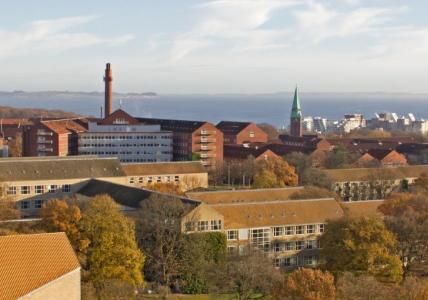The remnants of a Europe in conflict can to this day still be found on the seabed of the North Sea. More than seventy years after World War II and a hundred years after World War I, The North Sea Region funded project North Sea Wrecks (NSW) aims to find joint solutions to this shared problem.
Kicking off a joint adventure

On 17 October 2018, nine partners from five countries surrounding the North Sea convened at the premises of the Lead Beneficiary, German Maritime Museum in Bremerhaven.
The setting of the event was second to none as the museum allows visitors to see the different types of ships and munitions which may still be found in the North Sea.
The setting of the event was second to none as the museum allows visitors to see the different types of ships and munitions which may still be found in the North Sea.

NSW partners at the Kick-off meeting Photo:@DSM/Klama
Participating in the kick-off meeting as a member of the Joint Secretariat, I gained a great insight into the project set-up and the knowledge of the experts working on the project.
How transnational cooperation can be the solution
The challenges faced by North Sea Wrecks are perfect examples of transnational challenges which require a transnational approach to overcome them.
The Ministry of Environment of the German state of Schleswig-Holstein chairs the North Sea Wreck Advisory Board. Jens Sternheim from the Ministry states: ‘The German part of the North Sea was a theatre of all kinds of military sea and air operations (naval and air battle, air raids, sea combat, training, manoeuvre, accidents) in World War I and II. Thousands of ships and planes with oil, munitions and other hazardous goods on board sank to the sea bed. In addition, mine laying and counter mine operations introduced more than one million sea mines to the North Sea and after World War II 1.3 million tonnes munitions, along with other warfare material, were dumped in the German part of the North Sea alone’.
His colleague a the Ministry Claus Böttcher adds: ‘There is evidence that at least 45 ships and ship hulls filled with chemical weapons and bulk containers with Chemical Warfare Agence in the order of 200,000 to 290,000 metric tonnes were sunk in the Skagerrak, between Denmark and Norway and just off the Swedish island Måseskär.’
Michiel Vandegehuchte from the Flemish project partner VLIZ Oostende complements: ‘Also in the Belgian part of the North Sea, World War shipwrecks of both German and Allied origin can be found, containing munition, oil or other hazardous cargo.’
The project is funded under priority 3 of North Sea Region Programme, which is targeting the preservation of the environment, and more specifically for this project it is linked to the priority specific objective ‘Develop new methods for the long-term sustainable management of North Sea ecosystems’.
One of the major areas of focus for this project is the munitions from World War II from sunken ships, left on the seabed of the North Sea. An interesting learning point from the kick-off meeting was that the munitions do not only pose a risk of explosion, there are also polluting factors which have to be considered.
An example of this was presented by one of the partners who had been experimenting with the effect which unexploded ammunition has on mussels: They had found a significant correlation between the proximity of TNT and the uptake of TNT residues in the living organism. Another interesting aspect is the discovery of the effect of blasting the munition to remove it: This scatters the residues over a larger area, causing negative effects on the surrounding aquatic environment.
A flying start
North Sea Wrecks has been very successful at raising initial awareness of the project which has so far has resulted in two TV features and various newspaper articles. The project has also been featured in the newscast “Aktuell” at Norddeutscher Rundfunk (Germany).
Spreading the word about the project also increases the awareness of how important the challenge is, and why a coordinated effort across borders is needed. The project aims to provide a comprehensive methodology to assess, investigate and describe respective data sources, including the mapping of maritime heritage sites. In addition, the project will deliver methods for exploring potential data and field sampling with research vessels. With these methods implemented the project will create; a Decision Support Database based on case studies, a risk assessment methodology and policy recommendations.
The legacy of the project
Already before the launch of the project it has been considered how the legacy of the project could be maintained after its official closure.
During the project lifetime, North Sea Wrecks will present its preliminary results in a travelling exhibition visiting several countries. This will allow the wider public and the target groups of the project to get a first-hand experience of the project’s work.
After the official completion of the project, the plan is to convert the travelling exhibition or elements from it into a permanent exhibition at the German Maritime Museum. This unique cradle-to-cradle approach could serve as a lighthouse for future project dissemination in the North Sea Region.
I am very much looking forward to follow the project and what solutions the partners can co-create. If you want to stay tuned, you can follow the project at their webspace.
Facts about the project
Duration: 4 years
Total budget: 4.2 Million Euro

The project consortium includes partners from five North Sea Region countries.
North Sea Wreck partnership
- Deutsches Schiffahrtsmuseum – Leibniz-Institut für deutsche Schifffahrtsgeschichte (Germany)
- Alfred-Wegener-Institut Helmholtz-Zentrum für Polar- und Meeresforschung (Germany)
- Vlaams Instituut voor de Zee vzw (Belgium)
- Aarhus University – Department of Geoscience (Denmark)
- Stichting NHL Stenden Hogeschool – Maritiem Instituut Willem Barentsz (The Netherlands)
- EGEOS GmbH (Germany)
- Periplus Consultancy BV (The Netherlands)
- Forsvarets Forskningsinstitutt (Norway)
- Universitätsklinikum Schleswig-Holstein – Institut für Toxikologie und Pharmakologie (Germany)



